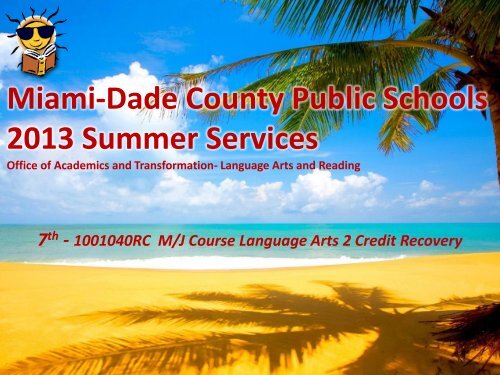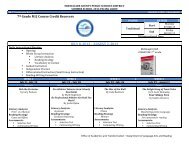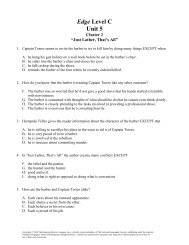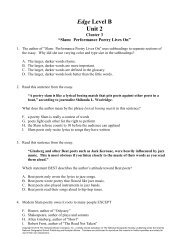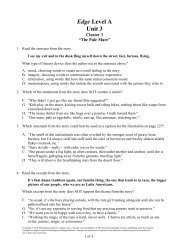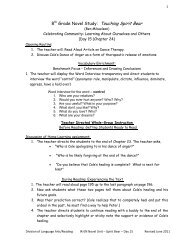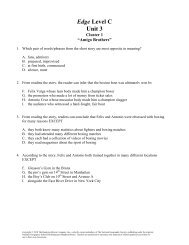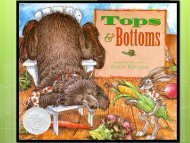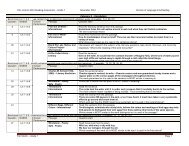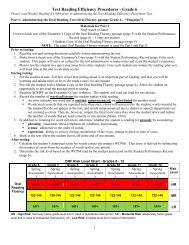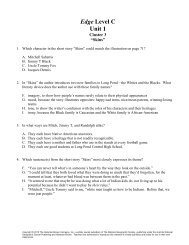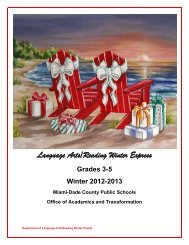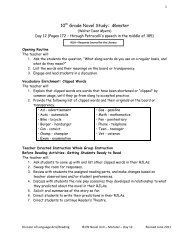Miami-Dade County Public Schools 2013 Summer Services
Miami-Dade County Public Schools 2013 Summer Services
Miami-Dade County Public Schools 2013 Summer Services
You also want an ePaper? Increase the reach of your titles
YUMPU automatically turns print PDFs into web optimized ePapers that Google loves.
<strong>Miami</strong>-<strong>Dade</strong> <strong>County</strong> <strong>Public</strong> <strong>Schools</strong><br />
<strong>2013</strong> <strong>Summer</strong> <strong>Services</strong><br />
Office of Academics and Transformation- Language Arts and Reading<br />
7 th - 1001040RC M/J Course Language Arts 2 Credit Recovery
Ice-Breaker
Objectives<br />
‣Preview the Course Recovery Curriculum<br />
‣Utilize classzone access materials for each lesson<br />
‣Examine the instructional objectives and delivery model<br />
‣Model the steps for a gradual release of instruction<br />
‣Conduct a 5 day lesson-walk using the MacDougal Littell Teacher’s<br />
Edition textbook
Instructional<br />
Routine<br />
A reliable and steady<br />
instructional routine that<br />
allows the student to<br />
become comfortable with<br />
the way instruction is<br />
taught so they can<br />
concentrate on what is to<br />
be learned.
Thinking Through Your<br />
Instructional Objectives<br />
1. What should<br />
students<br />
know and be<br />
able to do<br />
(objective)?<br />
6. Based on classroom<br />
participation, student work<br />
products, and<br />
weekly<br />
assessment data,<br />
data, how do I refine<br />
the learning<br />
experiences?<br />
2. How does this<br />
lesson objective fit<br />
into the “big picture”<br />
of instruction this<br />
summer?<br />
• Introduction of skill<br />
• Review of skill<br />
• Introduction of skill at<br />
more complex level<br />
5.What resources<br />
will I use?<br />
3. How will I,<br />
and they,<br />
know when<br />
they are<br />
successful?<br />
4. What learning<br />
experiences will<br />
facilitate their<br />
success?<br />
6
Gradual Release of Responsibility<br />
Instructional Delivery Model<br />
Framework of Doug Fisher and Nancy Frey
Whole Group Instruction<br />
<br />
this instruction establishes purpose, models<br />
thinking, demonstrates skills to be learned,<br />
and teaches for metacognition<br />
<br />
<br />
<br />
<br />
<br />
<br />
focuses on a lesson and clearly establishes a<br />
purpose for learning<br />
the teacher uses “I” statements to model<br />
thinking<br />
questioning is used to scaffold instruction,<br />
not to interrogate students<br />
provide students with information about<br />
the ways in which a skilled reader, writer, or<br />
thinker processes information<br />
systematically moves to guided instruction,<br />
not immediately to independent learning<br />
typically lasts around 15 minutes<br />
(depending on the age group)
Guided Instruction<br />
<br />
<br />
<br />
<br />
<br />
<br />
<br />
scaffold instruction<br />
connection between the modeled<br />
instruction and independent<br />
performance<br />
this Instruction and tasks require the<br />
joint intellectual effort, of jigsaws,<br />
cooperative learning groups, numbered<br />
heads together, etc<br />
almost always done with small,<br />
purposeful groups<br />
consist of students who share common<br />
instructional needs that the teacher<br />
may address<br />
ideal time to differentiate based on<br />
needs<br />
cues, prompts, & questions
NOT the time to introduce new information<br />
NOT simply “group work” in which a single<br />
product is produced for the group<br />
NOT ability grouping<br />
Collaborative Instruction<br />
collaborative/cooperative tasks<br />
EACH student is accountable to produce<br />
something based on the group<br />
instruction.<br />
positive interdependence<br />
individual and group accountability<br />
interpersonal and small-group skills<br />
group processing<br />
reciprocal teaching<br />
listening/viewing demonstrations<br />
literature circles/book clubs<br />
jigsaw<br />
skills practice<br />
requires the use of social and academic<br />
language<br />
individual accountability is a hallmark<br />
this instruction is the critical bridge in<br />
student learning – allows novice learners<br />
to refine their thinking about new<br />
concepts & skills
Independent Practice<br />
NOT just a “pile of worksheets”<br />
NOT just an exercise in rote<br />
memorization<br />
NOT necessarily silent<br />
Not just “Do It Yourself School”<br />
both a goal AND a process<br />
students should not be asked to do unfamiliar<br />
tasks - tasks for which they have not had<br />
instruction previously<br />
students have received focus lessons, guided<br />
instruction, and collaborative learning<br />
experiences related to concepts needed to<br />
complete independent tasks<br />
independent tasks extend beyond practice to<br />
application and extension of new knowledge<br />
the teacher meets with individual students for<br />
conferencing about the independent learning<br />
tasks a necessary<br />
is based on meaningful learning activities<br />
enables individual learners to take<br />
responsibility for their own learning<br />
is not successful if it happens too early in the<br />
instructional process<br />
students fully assume the cognitive load of<br />
learning by applying what they have learned to<br />
novel tasks
Differentiated Instruction<br />
NOT a "one size fits all" approach<br />
NOT only whole group instruction<br />
NOT assigning task with less<br />
cognitive demand<br />
provide students with different avenues to<br />
acquiring content<br />
differentiate instruction through: 1) content,<br />
2) process, 3) product, and 4) learning<br />
environment based on the individual learner<br />
develop personalized instruction so that all<br />
children in the classroom can learn effectively<br />
respond to student variety in readiness levels,<br />
interests and learning profiles<br />
set different expectations for task completion<br />
for students based upon their individual needs<br />
align tasks and objectives to learning goals<br />
provide a balance between teacher-assigned<br />
and student-selected tasks
Reading Writing Connection<br />
NOT just assigning students to read<br />
or write randomly<br />
NOT just providing students with a<br />
graphic organizer while reading<br />
Definitely NOT just reading words<br />
and answering questions.<br />
reading affects writing and writing affects reading<br />
reading instruction is most effective when<br />
intertwined with writing instruction and vice versa<br />
the reader needs to read with the sense of the<br />
writer and the writer needs to write with the sense<br />
of the reader<br />
a reader needs to make sense of what the writer is<br />
communicating through the text and the writer<br />
need to make sure that his/her message is clear and<br />
understood by the reader<br />
reading helps children learn text structures and<br />
language that they can then transfer to their own<br />
writing<br />
reading provides students with prior knowledge<br />
that they can use in their writing<br />
practice in the process of writing their own texts<br />
helps students analyze the pieces that they read<br />
show and discuss models that successfully<br />
demonstrate the skill<br />
students should be given opportunities to practice<br />
the writing skill
No…..<br />
TEACHER RESPONSIBILITY<br />
(none)<br />
Independent<br />
“You do it<br />
alone”<br />
STUDENT RESPONSIBILITY<br />
Fisher, D., & Frey, N. (2008). Better learning through structured teaching: A framework for the gradual<br />
release of responsibility. Alexandria, VA: Association for Supervision and Curriculum Development.
In some classrooms …<br />
TEACHER RESPONSIBILITY<br />
Whole Group Instruction<br />
“I do it”<br />
Independent<br />
“You do it<br />
alone”<br />
STUDENT RESPONSIBILITY<br />
Fisher, D., & Frey, N. (2008). Better learning through structured teaching: A framework for the gradual<br />
release of responsibility. Alexandria, VA: Association for Supervision and Curriculum Development.
The “Good Enough” Classroom<br />
TEACHER RESPONSIBILITY<br />
Whole Group Instruction<br />
“I do it”<br />
Guided<br />
Instruction<br />
“We do it”<br />
Independent<br />
“You do it<br />
alone”<br />
STUDENT RESPONSIBILITY<br />
Fisher, D., & Frey, N. (2008). Better learning through structured teaching: A framework for the gradual<br />
release of responsibility. Alexandria, VA: Association for Supervision and Curriculum Development.
A Model for Success for All Students<br />
TEACHER RESPONSIBILITY<br />
Whole Group Instruction<br />
Guided<br />
Instruction<br />
“I do it”<br />
“We do it”<br />
Collaborative<br />
“You do it<br />
together”<br />
Independent<br />
STUDENT RESPONSIBILITY<br />
“You do it<br />
alone”<br />
Fisher, D., & Frey, N. (2008). Better learning through structured teaching: A framework for the gradual release of<br />
responsibility. Alexandria, VA: Association for Supervision and Curriculum Development.
• Author Online – Ask students to read the “Author Online”<br />
section and explain why the information was separated<br />
using the subheadings provided. (Discussion)<br />
• Background – Teacher read-aloud background to students.<br />
Engage students in a discussion.<br />
• Literary Analysis – Teach Point of View in a Memoir (1 st<br />
person POV) using “Standards Focus” (TE pg.269)<br />
• 1 st Read – Students read independently<br />
• Clarify Text – Teacher use the Literary Analysis chart (OLR<br />
pg. 177) to guide students through the process of recording<br />
things the author states directly about himself and<br />
questions that they may have about him after reading the<br />
memoir.
• Review Reading Strategy: POV of in a Memoir<br />
• Teach Cause and Effect – Use “Standards Focus” and<br />
“Reading Skill: Identify Cause and Effect” for guided<br />
instruction. (TE pg.269) Introduce (OLR pg.179)<br />
• Guided Reading – Conduct a guided reading with students.<br />
Stop at targeted sections of the text to ask guiding<br />
questions related to POV and Cause & Effect. Engage<br />
students in a rich discussion. Using a collaborative<br />
grouping technique students complete (OLR pg. 179) to<br />
identify cause-and effect relationships in the memoir<br />
• Comprehension Check– Have students complete the quick<br />
comprehension check in the SE pg. 277 (1-3) as an exit slip.
•Review Reading Strategy: Cause and Effect<br />
•Teach-Vocabulary In Context: Using a collaborative instruction<br />
model allow students to make a chart like the one shown on page<br />
269 in the SE/TE and put the listed vocabulary words in the<br />
appropriate column. Use (OLR pg. 181) to conduct a guided<br />
Vocabulary Study. Students should write a student friendly definition<br />
for each word after the teacher reads each set of sentences and<br />
discuss the possible meaning of the word.<br />
•Audio Reading: Students listens and follows an audio recording of<br />
the text paying close attention to vocabulary from the Vocabulary In<br />
Text lesson.<br />
• Students independently complete the (OLR pg. 182).<br />
•Vocabulary In Writing: Using SE/TE pg. 278, students write to<br />
demonstrate ability to apply learned vocabulary.<br />
•Practice Literary Analysis: Students complete FCAT Exercises (4-8).
•Review Reading Strategy: Vocabulary in Context, ask students to revise<br />
the student friendly definitions from the vocabulary lesson. Through<br />
discussion and revisiting the text allow students to revise definitions as<br />
necessary.<br />
•Teach Vocabulary Strategy: Idioms – Using guided instruction to teach<br />
TE/SE 278, have students read aloud each idiom and discuss what type of<br />
image is created.<br />
•Paired Reading: Using a collaborative instruction method, allow<br />
students to reread the text paying close attention to idioms. Provide a<br />
reading check (OLR pg. 184) following the reread of the text.<br />
•Practice Vocabulary Strategy: Idioms – Allow students to independently<br />
demonstrate ability to comprehend and apply idioms in writing using<br />
(OLR pg. 183).<br />
•Reading-Writing Connection: Students will reread text lines 4-22 to<br />
respond to Writing Prompt . They are asked to recall the choices Paulsen<br />
made, then write a short response to analyze how Paulsen’s choices<br />
effected his survival. Students are expected to use more than one choice<br />
and explain how each choice made a difference.(TE pg. 279)
• Review Vocabulary Strategy: Idioms<br />
• Teach- Grammar and Writing-Avoid Misplaced Modifiers:<br />
Use the SE/TE pg. 279 to address the use of prepositions.<br />
Through guided instruction, students will rearrange words,<br />
sentences, and paragraphs to develop relationships among<br />
ideas.<br />
• Independent Reading: Students practice strategies that they<br />
learned during the other instructional contexts along the<br />
gradual release of responsibility.<br />
• Culminating Writing Assessment: Revise the writing to<br />
Writing Prompt A from Thursday, Day 4.<br />
• Selection Assessment: Use selection Test B/C to formally<br />
assess students mastery of the lesson benchmarks. (OLR pg.<br />
189-190).
Less- Proficient Readers<br />
In combination with the Audio Anthology, use one or more<br />
Targeted Passages (Pg. 270, 275, 276) to ensure that students<br />
focus on key selection events, concepts and skills.<br />
1) Targeted Passage [ Lines 1-14]<br />
This passage introduces the author and the conflict he faced<br />
at this point in his life: the struggle to survive alone on the<br />
streets.<br />
• Why did Paulsen become a “street kid”?<br />
• Where does he live?<br />
• What kind of work does he do in the summer? Why<br />
doesn’t he do this work the rest of year?<br />
English Learners<br />
Have students use Word Questioning to learn this vocabulary:<br />
income (line 22), target (line 30), area (line 40), policy (line<br />
79), remove (lines 118 and 192), constant (line 185).
Advanced Learners<br />
Pre-AP exercises in the bottom channel provide additional<br />
challenge for your advanced students. Use them for small<br />
groups or individuals.<br />
Point out the simile Paulsen uses in lines 112-113 to show how<br />
hungry Dirk is: the burger “disappeared down his throat as if a<br />
hole had opened into the universe.” Challenge students to<br />
identify another characteristic of Dirk or Paulsen and use an<br />
original simile to describe it. Have students share their similes<br />
with the class.
Dr. Sharon Scruggs-Williams<br />
District Supervisor<br />
sscruggs-williams@dadeschools.net<br />
(305)995-1992<br />
Tashimba L. Andrews, Ed.S.<br />
Curriculum Support Specialist<br />
Kim McKinnis, MS<br />
Curriculum Support Specialist<br />
tandrews@dadeschools.net<br />
kmckinis@dadeschols.net<br />
305.995.3122 305.995.3122


